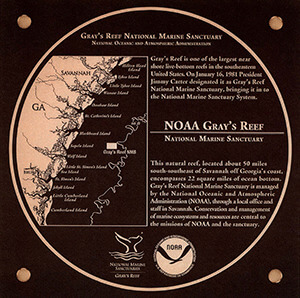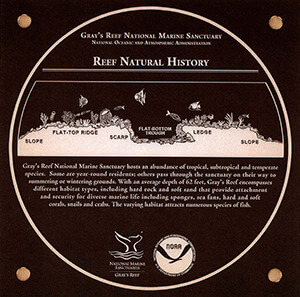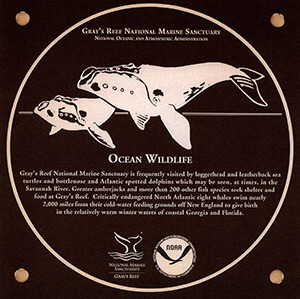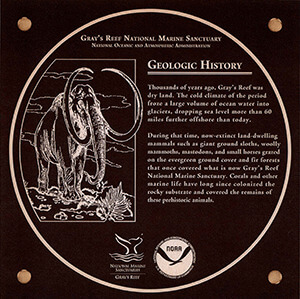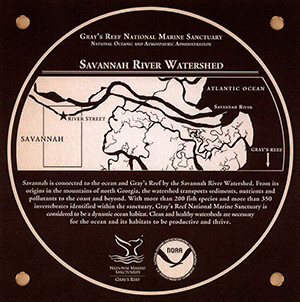Underwater Robot Competition Offers Impressive Display of Technical and Design Skills
As you stroll Savannah's Historic Riverfront alongside the fast-moving, nutrient-laden waters of the Savannah River, over 75,000 gallons of fresh water pour into the Atlantic Ocean every second just a few miles to the east. Eventually, some of that same water may wash over the colorful reef formations and diverse habitats of NOAA Gray's Reef National Marine Sanctuary some 35 miles to the southeast.
Gray's Reef is intricately connected to downtown Savannah by the river; however most will never see the glory of the reef because it is so far offshore in relatively deep water. Our markers bring Gray's Reef to you and millions of visitors and locals visiting River Street each year. These classic bronze markers you see today in Rousakis Plaza impart important events and facts about Gray's Reef.
Let us know what you think of them and send us a selfie with your favorite marker. If you let us know where you live, we'll mark your city on our map.
If you have children, please bring blank pieces of paper and crayons or chalk for them to make rubbings of the images. They'll love the reef top, mastodon, loggerhead sea turtles and right whales!
The markers and their text appear below. They are listed below as they appear from west to east beginning on the west end of Rousakis Plaza:
NOAA Gray's Reef National Marine Sanctuary:
Gray's Reef is one of the largest near-shore live-bottom reefs in the southeastern United States. On January 16, 1981 President Jimmy Carter designated it as Gray's Reef National Marine Sanctuary bringing it in to the National Marine Sanctuary System. This natural reef, located about 50 miles south-southeast of Savannah off Georgia's coast, encompasses 22 square miles of ocean bottom. Gray's Reef National Marine Sanctuary is managed by the National Oceanic and Atmospheric Administration (NOAA), through a local office and staff in Savannah. Conservation and management of marine ecosystems and resources are central to the missions of NOAA and the sanctuary.
Reef Natural History:
Gray's Reef National Marine Sanctuary hosts an abundance of tropical, subtropical and temperate species. Some are year-round residents; others pass through the sanctuary on their way to summering or wintering grounds. With an average depth of 62 feet, Gray's Reef encompasses different habitat types, including hard rock and soft sand that provide attachment and security for diverse marine life including sponges, sea fans, hard and soft corals, snails, and crabs. The varying habitat attracts numerous species of fish.
Ocean Stewardship:
On average, nearly 75,000 gallons of fresh water flow from the Savannah River into the Atlantic Ocean every second. Trash in the Savannah River can be carried offshore and may eventually reach Gray's Reef National Marine Sanctuary. Discarded fishing gear can lethally entangle whales, dolphins and sea turtles, and many animals can mistake litter and trash for food. Properly discarding trash is essential for a clean environment and a healthy ocean.
Ocean Wildlife:
Gray's Reef National Marine Sanctuary is frequently visited by loggerhead and leatherback sea turtles, and bottlenose and Atlantic spotted dolphins which may be seen, at times, in the Savannah River. Greater amberjacks and more than 200 other fish species seek shelter and food at Gray's Reef. Critically endangered North Atlantic right whales swim nearly 2,000 miles from their cold-water feeding grounds off New England to give birth in the relatively warm winter waters of coastal Georgia and Florida.
Geologic History:
Thousands of years ago, Gray's Reef was dry land. The cold climate of the period froze a large volume of ocean water into glaciers, dropping sea level more than 60 miles further offshore than today. During that time, now-extinct land-dwelling mammals such as giant ground sloths, wooly mammoths, mastodons, and small horses grazed on the evergreen ground cover and fir forests that once covered what is now Gray's Reef National Marine Sanctuary. Corals and other marine life have long since colonized the rocky substrate and covered the remains of these prehistoric animals.
Savannah River Watershed:
Savannah is connected to the ocean and Gray's Reef by the Savannah River Watershed. From its origins in the mountains of north Georgia, the watershed transports sediments, nutrients and pollutants to the coast and beyond. With more than 200 fish species and more than 350 invertebrates identified within the sanctuary, Gray's Reef National Marine Sanctuary is considered to be a dynamic ocean habitat. Clean and healthy watersheds are necessary for the ocean and its habitats to be productive and thrive.


